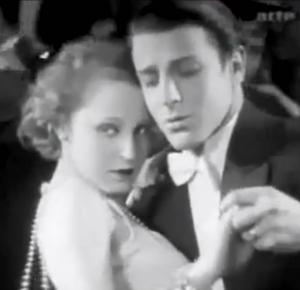- Historical Dance
- Jazz Age Social Dancing ("The Modern Dances")
- 0. The Essentials of Jazz Age Ballroom Dancing
- 1. Foxtrot Part 1: The Jazz Age Foxtrot
- 2. Youth Dancing in the Jazz Age
- 3. The Jazz Age Waltz
- 4. The Jazz Age Tango
- 5. 1930s Rumba
- 6. 1930s Samba
- 7. 1930s Conga
- 8. Bal Musette: Parisian Dance of the Jazz Age
- 9. Dancing in Weimar Berlin
- Dancing Made Easy - 1922
- Film Library - Jazz Age Dance
- Historical Dance Films posted to Pinterest
- Jazz Age Dance - Apologia
- Jazz Age Dance Image Collection
- Jazz Age Lead and Follow
- Places to Dance in Southern California in the Jazz Age
- Sampler of Jazz Age Dance Holds
- The Pathé Historical Dance Collection: 1920s-40s
- Ragtime Dance - the One Step
- Regency Dance
- Victorian Dance
- Jazz Age Social Dancing ("The Modern Dances")
9. Dancing in Weimar Berlin
 Germany during the era of the Weimar Republic (1919-1933) was a place of political conflict and economic chaos; as well as a nexus of cultural ferment, a flowering of invention and creativity, and a rejection of pre-Great War social norms and cultural conventions. It was also notorious for the vitality of its decadent night life, awash in sex and booze and jazz music: jazz music provided by hot German bands with their own distinctive national sound.
Germany during the era of the Weimar Republic (1919-1933) was a place of political conflict and economic chaos; as well as a nexus of cultural ferment, a flowering of invention and creativity, and a rejection of pre-Great War social norms and cultural conventions. It was also notorious for the vitality of its decadent night life, awash in sex and booze and jazz music: jazz music provided by hot German bands with their own distinctive national sound.
The dance of fashionable Weimar Germany was indistinguishable from the dancing you would see in London or New York. In the countryside or in "folk" events, you might well see good old fashioned rotary Waltzes, as well as dances like the Polka, LĂ€ndler, Zweifacher etc.; but in the night clubs of sophisticated cities like Hamburg or Berlin, only modern dances like the Foxtrot, Tango, Passo Doble and the "modern" Waltz were welcome. Occasionally, the Charleston would make an appearance.
The first clip below is from a 1928 German film called "Abwege" ("Astray") directed by G.W. Pabst, whose stylishly executed films frankly addressed previously taboo subjects like sex (including homosexuality), prostitution and drug abuse. The woman at the center of this clip is Brigitte Helm, whom you might recognize if you've seen Fritz Lang's "Metropolis".
In this clip, in addition to a fair sense of Weimar decadence and excess, you can see the Tango and the uptempo Jazz Foxtrot being danced in their natural environment: a crowded, smokey, boozy, upscale Jazz nightclub.
It was, of course, a silent film so I added a soundtrack of original recordings from German bands of the 1920s and '30s.
Below that is a mashup of a couple of 1930s films showing Germans dancing the Modern Waltz and below that, a Paso Doble.
Music:
Tango Eine Nacht in Monte Carlo: Marek Weber und seinem Orchester
Foxtrot Arpaneetta: Robert Gaden und seinem Orchester
Foxtrot Ungaarwein: Barnabas von Geczy und seinem Orchester
Tango Ich weiĂ so viel von dir, Elisabeth: Fritz Weber und seinem Orchester
Foxtrot GruĂ und KuĂ Veronika: Die Weintraubs
And here are some examples of the Germans performing the "Modern" Waltz.
This is a clip of Germans dancing to a Paso Doble. There were lots of Paso Dobles recorded in the 20s & 30s, but I have found almost no examples of them being danced in a social setting. It would appear that the step is essentially very fast-footed One-Step/Foxtrot, a bit like a Samba, but without the back-and-forth, hip-swaying. More just step-step-step-step-step.... with a bit of a spring. I don't imagine the promiscuous partner switching was an essential element of the German Paso Doble.
